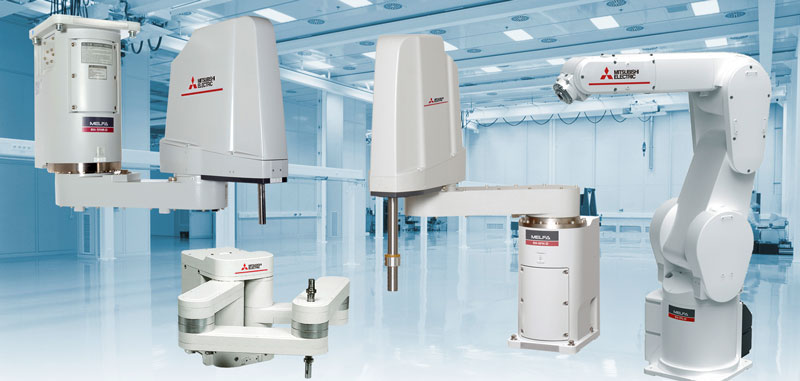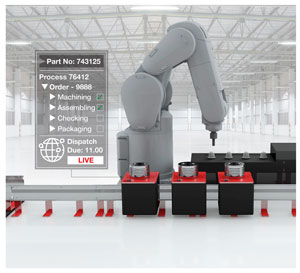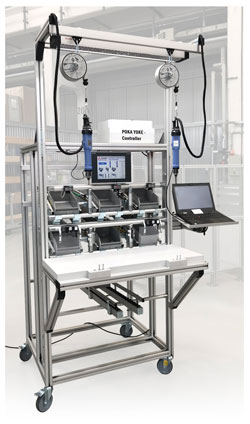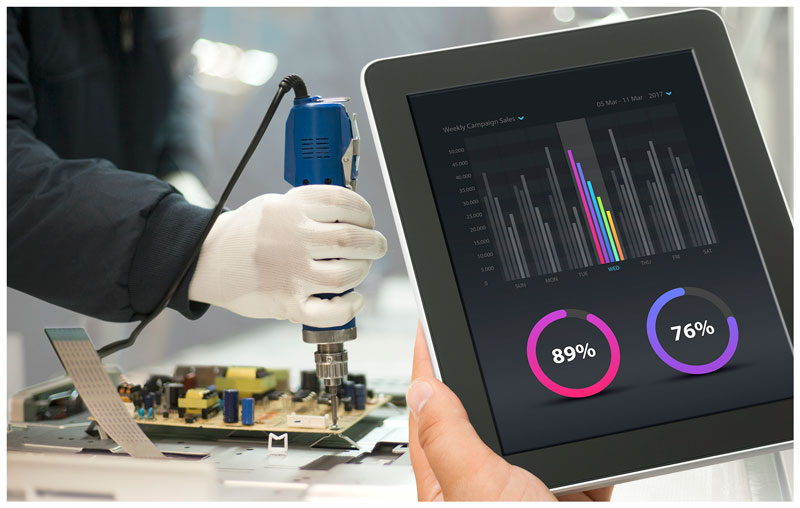Mitsubishi brought it all to the 2017 SPS Drives show
Mitsubishi Electric had a very busy show at this year’s SPS Drives showcasing a range of new products and solutions from collaborative robots, to modular linear transfer systems and smart carriages, especially as the company was like many, concentrating on the big focus of the show Industry 4.0 and digitalisation. Anna Flockett, Engineering Specifier editor attended the Mitsubishi press breakfast at the SPS show, where the first innovation that was easily noticed was the demonstration of production in an Industry 4.0 environment which included a new collaborative robot, working together with an operator without safety barriers.
Collaborative robots are the future
Collaborative robots are designed to work in close proximity with people in a production cell, unlike fast and powerful industrial robots which have to be located behind protective barriers for safety reasons. Free from this restriction, collaborative robots can be readily and flexibly deployed anywhere in the production environment.
Importantly, while the precision of some collaborative robots may be reduced in comparison with industrial versions, the Mitsubishi Electric model’s performance characteristics mirror those of the company’s industrial autonomous robot range. This means a repeat accuracy of ±0.02mm, despite the inclusion of sensitive force/torque sensors. Load capacity of the shown robot model is between 5 and 6kg and reach is between 800 and 1000 mm.
As well as performance, Mitsubishi Electric also addressed its ease of use, with innovative and, to date, distinctive control and programming options. A touch-screen operator terminal was on show, which can be plugged into the robot, provides an intuitive interface to ‘teach’ the robot its task, without any special programming expertise.

The teach functionality includes a ‘direct control’ mode which allows the operator to move the robot from position to position, by hand and with controlled force. Once the set-up is complete, the operator terminal is easily removed to give the robot full freedom of movement.
The launch of the new collaborative MELFA robot actually marked the company’s first dedicated development in the area of Human-Robot Cooperation (HRC).
Being smart with digitalisation
Also at the show, the company was highlighting how to be smart with digitalisation, a topic which could be heard and seen absolutely everywhere in Nuremberg at the show.
Mitsubishi decided to show visitors how digitalisation can increase their production flexibility, as if you make use of integrated automation platforms new opportunities can be found for shop floor optimisation.
e-F@actory
Take the e-F@ctory concept for example, this Mitsubishi solution is providing a practical structure for enabling the process of digital transformation to happen at a manufacturing level.
This aspect of the Mitsubishi stand was designed especially to help machine and plant experience this approach by exploring a live demonstration which presented how data could be collected from shop floor devices and transferred to a higher level SCADA-System for visualisation, monitoring and interpretation of the production process.
 “This presentation contains three connected applications that demonstrate production processes in real-time,” explained Klaus Petersen, Marketing Director of Mitsubishi Electric’s Factory Automation – European Business Group. “Apart from the operating status and performance information, users can also receive additional information as guidance - such as reasons for, and the steps to take on predictive maintenance.”
“This presentation contains three connected applications that demonstrate production processes in real-time,” explained Klaus Petersen, Marketing Director of Mitsubishi Electric’s Factory Automation – European Business Group. “Apart from the operating status and performance information, users can also receive additional information as guidance - such as reasons for, and the steps to take on predictive maintenance.”
The three applications are connected to each other using a MAPS SCADA-System that employs production visualisation to display data and monitoring information on a Mitsubishi Electric display wall cube. This networked system includes an automated product recognition system and a part-automated zero-defect Guided Operator Solution, in combination with a cooperative ‘Safe Skin’ robot.
By making use of Edge Computing technologies, processed data can then be handed over via the Cloud for deeper analysis of production data and to integrate with higher-level business systems or even Smart Device applications. The results support new methods for production management and enable increased transparency for enterprise resource planning (ERP).
Mitsubishi Electric tried to underline its capacity to offer a broad range of technologies for customers, from control and drive automation to edge computing solutions and cloud connectivity at this year’s show with its strong and consistent theme of ‘e-F@ctory – pushing business further.’
Smart Carriages
Moving on to some other key features, we saw a modular Linear Transfer System with Smart Carriages for intelligent control of product movement, processing and conveying.
These new versions of the Smart Carriages build on extensive existing technical advantages, which include on-board intelligence and data memory, plus freely configurable tracks – but now include on-board battery power to enable even more productivity.
Mitsubishi also took the time to address operator safety without compromising productivity, because as workers approach them, the Smart Carriages will slow down and then eventually, but only in the section where there is a potential hazard.
The innovative Linear Transfer System addresses industry challenges such as shorter response times to new market trends, increased demands for customisation, and cost pressures. It offers greater production line flexibility by using on-board intelligence and connectivity to allow each carriage to behave differently and autonomously. For example, the Smart Carriages can choose the optimum route to reach next station and enable processing of the product being carried as they go along.
The new on-board battery system not only powers on-carriage devices such as sensors, controllers and memory, but also drives the carriage itself. This offers key advantages over alternative systems because it removes the need to draw power from the track and increases layout flexibility. There are also reliability benefits, since there are no brushes contacting the track to draw motive power for the carriage, which can create dust and requires frequent cleaning. This advantage offers reduced maintenance and also makes the system suitable for use in clean environments.
A new safety concept allows cage-free operation and increased productivity. The implemented safety features such as Safe Torque Off (STO) and Safety Limited Speed (SLS) in combination with sensors detect when an operator is nearing the conveyor system and slow the carriages to a safe speed – but only in the local area where the operator might come into contact. Elsewhere on the LTS, operation continues at normal speeds and productivity is not compromised.
With a full suite of track pieces in different lengths and bend radii, and with the carriages being based on proven Mitsubishi Electric technologies, users can quickly and easily build a complete linear transfer system to meet their individual requirements.
The PLC platform
At SPS, Mitsubishi also took the time to highlight the benefits of the PLC as a platform for automation, as it had a complete set of dedicated CPU modules for the MELSEC iQ‑R Series PLC on show.
The Mitsubishi CNC CPU module and a robot control CPU, now complement the existing options for analogue and digital I/O, motion, positioning, process control, safety and networking, delivering a solution that integrates the full suite of control and automation processes onto one common platform.
Providing a complete automation system on a single PLC backplane, the modules provide control capabilities with reduced I/O processing times. Furthermore, direct integration with the PLC along with recent SIL2 (safety integrity level) certification helps to reduce total operation cycle times and guarantee performance levels.
The concept of the automation platform built around the MELSEC iQ‑R Series PLC makes it easier for integrators to develop systems, freed from traditional integration challenges, and with significantly reduced commissioning times. It also provides a foundation for smart manufacturing as part of the journey towards Industry 4.0.
There will also be a Total Factory Automation Solution, which shows the entire product portfolio connected together, including third-party motors. Application data from the robot, drive and control systems are transmitted to MAPS live.
Quality management and digitalisation in manual assembly operations
Finally on offer for visitors at the show, Mitsubishi impressed customers with its Guided Operator Solutions for manual assembly applications, which were there to demonstrate how improvements in quality and productivity can be achieved.
The solutions enable the seamless transfer of production data from manual assembly operations to higher-level enterprise systems, supporting the digital transformation within manufacturing.
Mitsubishi Electric’s Guided Operator Solutions are already being used by leading automotive OEMs to aid with quality control in manual assembly processes and efficient stock handling. Similarly, customers are using the solutions for assembly operations in the semiconductor industry to optimise product quality management. Among the many other areas of interest are life sciences and medical device assembly applications.

Giving the operator a clear visual indication of which parts to pick and in what sequence, the Guided Operator Solutions help to improve quality. This is especially important for today’s assembly operations that are becoming increasingly complex and as the costs of addressing potential quality problems grow.
Components are frequently sourced from many different locations around the world for assembly at a single location, and any given product might be assembled from a host of different parts which can look superficially similar to neighbouring components. The Guided Operator Solutions are proven to eliminate picking mistakes for these components.
At the same time, the Guided Operator Solutions can provide a link between the operator and the higher-level ERP/MES business systems. This, for example, enables new product specifications to be sent to manual assembly work places, and inventory tracking reported back from production for analysis.
Mitsubishi Electric’s Guided Operator Solutions are based on MELSEC PLCs and GOT series HMIs, complemented by a full range of switch types, photo-electric sensors, light curtains and door devices.










